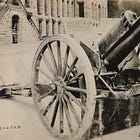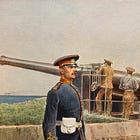Guns and Howitzers (The Rule of Two)
Armies of the First World War
For the past century or so, soldiers in the English-speaking world have used the terms “gun” and “howitzer” interchangeably. This practice stems from the fact that the majority of field artillery pieces adopted for service during this period have been weapons that, strictly speaking, belong to the category of “gun-howitzer.”
This was not always the case. At the start of the twentieth century, all people with more than a passing knowledge of cannon artillery could easily distinguish a “gun” from a “howitzer.” The former had a long barrel, which allowed the use of a lot of propellant to push a small projectile along a long, relatively flat trajectory. The latter had a short barrel, and used a modest charge to toss a large projectile along a short, relatively curved, path.
The formal dividing line that separated the long barrels of guns from the short barrels of howitzers varied from one army to the next. As a rule, however, it hovered in the vicinity of 20 “calibers.” That is, if the barrel of an artillery piece was longer than 20 times the diameter of the bore, the weapon qualified as a “gun.” If, however, the barrel was shorter than 20 times the diameter of the bore, the piece was a howitzer. Thus, for example, if a barrel with a 3-inch (76.2-millimeter) bore was more than 60 inches (1,524 millimeters) long, it belonged to a gun. If the barrel was less than 60 inches long, it belonged to a howitzer.
As a rule, the barrels of most howitzers in 1900 or so were much shorter than 20 calibers long. Indeed, most howitzers had barrels that were less than 15 calibers long. Similarly, most guns introduced in the first decade or so of the last century had barrels with lengths that were somewhere in the vicinity of 30 calibers. To put things another way, the barrel of a gun built in the early twentieth century was about twice as long as that of a contemporary howitzer that fired a projectile with the same diameter.
In addition to being twice as long as the barrel of a howitzer of the same caliber, the barrel of a gun weighed twice as much. Thus, as the weight of most of the other elements of an artillery piece had to be larger in order to accommodate the weight of the barrel, and larger still to resist the effects of a larger propellant change, a gun usually weighed at least twice as much as its short-barreled counterpart. Thus, the 155-millimeter (6.1-inch) howitzer adopted by the French Army in 1917, with a barrel that was 2,325 mm (92 inches) long, weighed 3,300 kilograms (1,500 pounds.) The 155-millimeter gun introduced to the same army in the same year, with a barrel length of 4,945 millimeters (195 inches), weighed 8,950 kilograms (19,690 pounds.)1
Because of the relationship between the weight of barrels and the size of the carriages upon which they were mounted, a gun firing a shell of a given weight weighed about as much a howitzer that fired a much heavier shell. Thus, the 3-inch (76.2-millimeter) field gun adopted by the US Army in 1905, which fired a 15-pound (6.8 kilogram) shell, weighed 2,520 pounds (1,145 kilograms.) The 3.8-inch (96-millimeter) howitzer introduced to the US Army in 1915, which fired 30-pound (17.6 kilogram) shell, weighed 2,040 pounds (927 kilograms.) Similarly, while the American 3.8-inch gun, Model 1906, which fired the same shell as the 3.8-inch howitzer, weighed 3,875 pounds (1,761 kilograms), the American 4.7-inch (120-millimeter) howitzer, Model 1913, which fired a 60 pound (27.3 kilogram) shell, weighed 3,988 pounds (1,812 kilograms.)2
In short, the relationship between the guns and howitzers used in World War II might well be described as “the rule of two.” A gun that fired a shell of a given size was, in rough terms, twice as heavy as a howitzer that fired of comparable projectile. A howitzer that weighed as much as a gun could toss a shell that was twice as large as the one the gun fired.
For Further Reading:
To Share, Subscribe, or Support:
Hans Linnenkohl, Vom Einzelschuß zum Feuerwalze: der Wettlauf Zwischen Technik and Taktik im Ersten Weltkrieg, (Osnabrück: Bernhard und Graefe Verlag, 1990), pages 227 and 231.
Bruce I. Gudmundsson, “Introduction,” to Sanders Marble, editor, King of Battle: Artillery in World War I, (Leiden: Brill, 2016), pages 4 and 5








Note: error in the kg/pounds relation in this paragraph: Thus, the 155-millimeter (6.1-inch) howitzer adopted by the French Army in 1917, with a barrel that was 2,325 mm (92 inches) long, weighed 3,300 kilograms (1,500 pounds.)